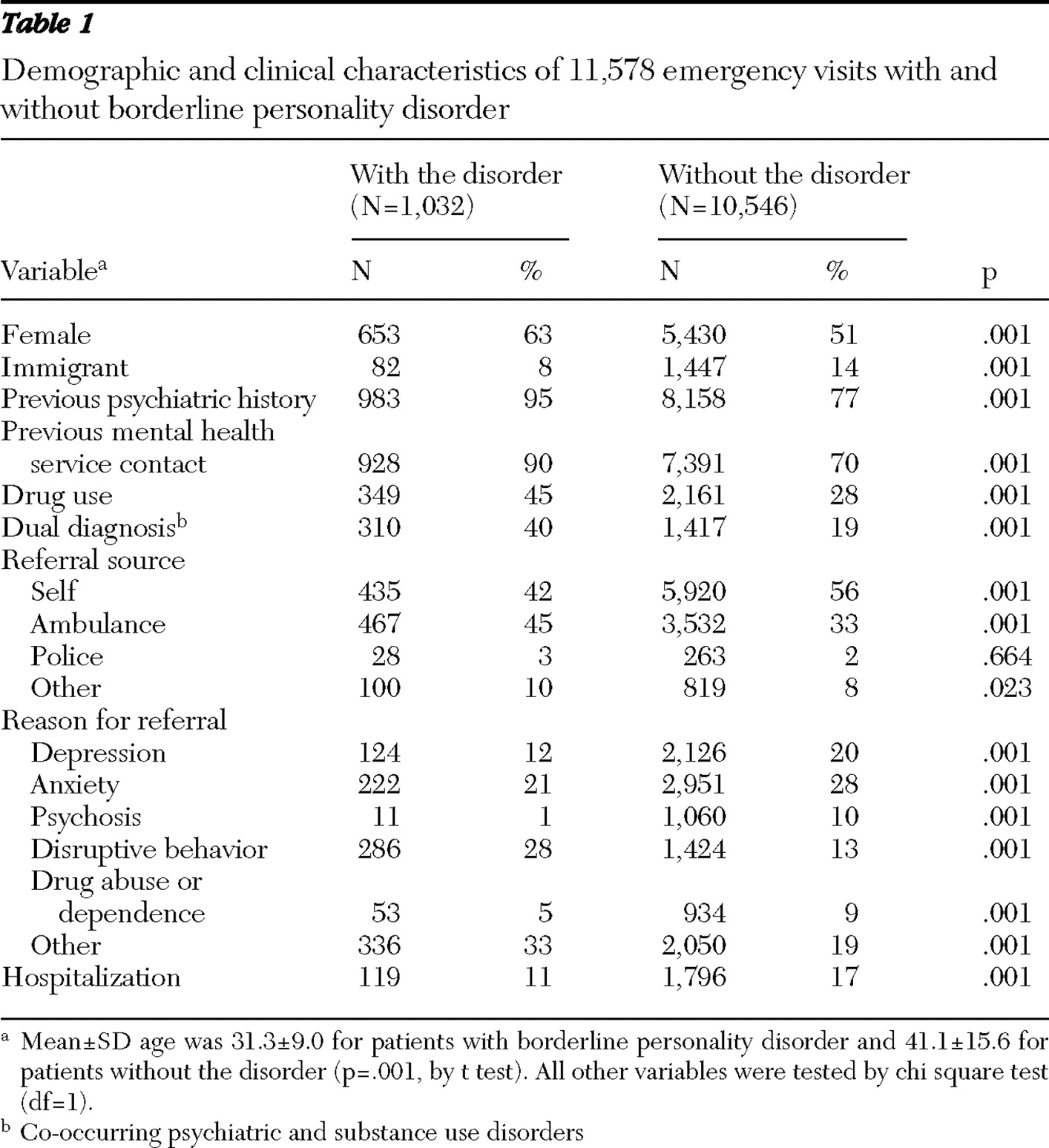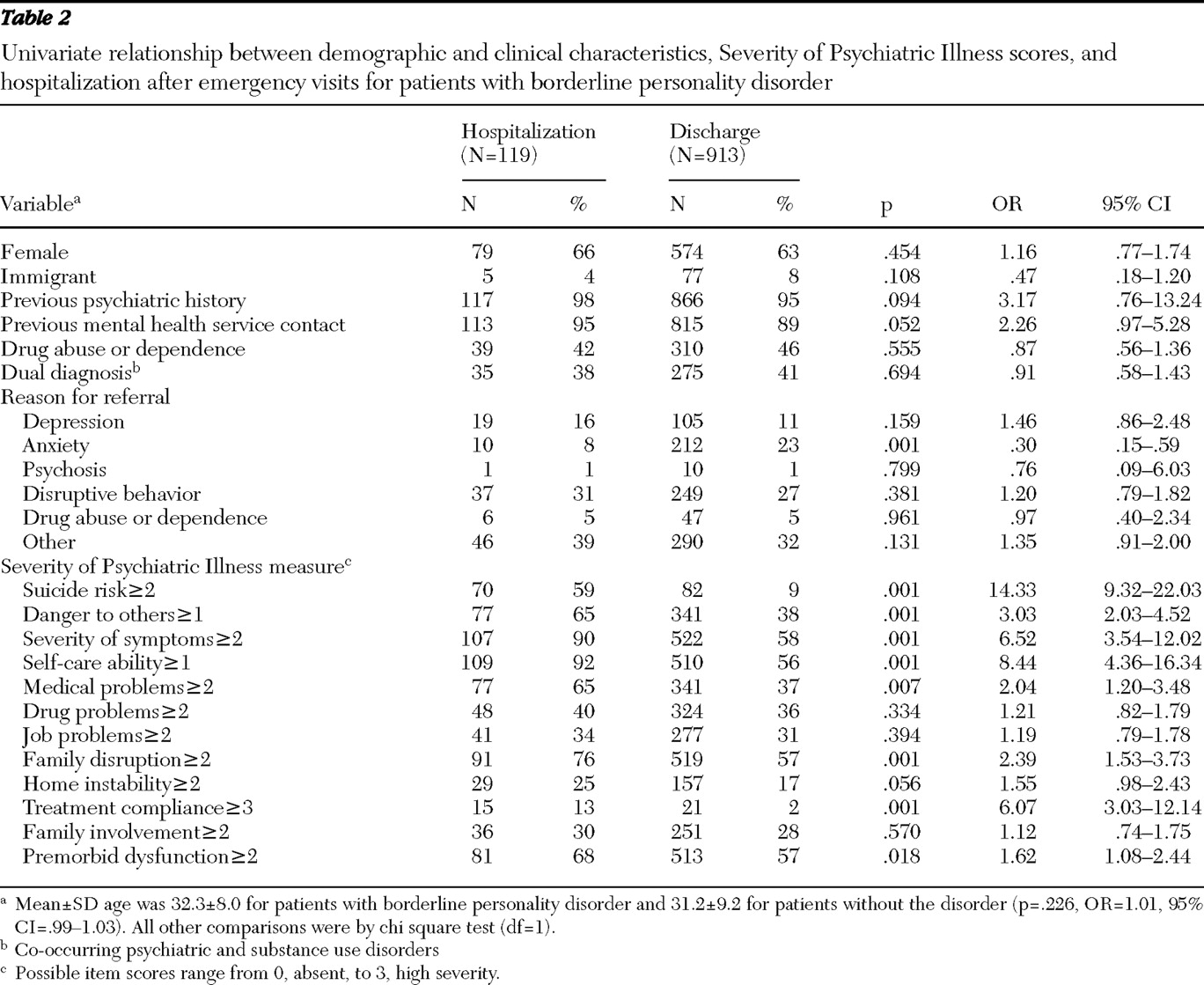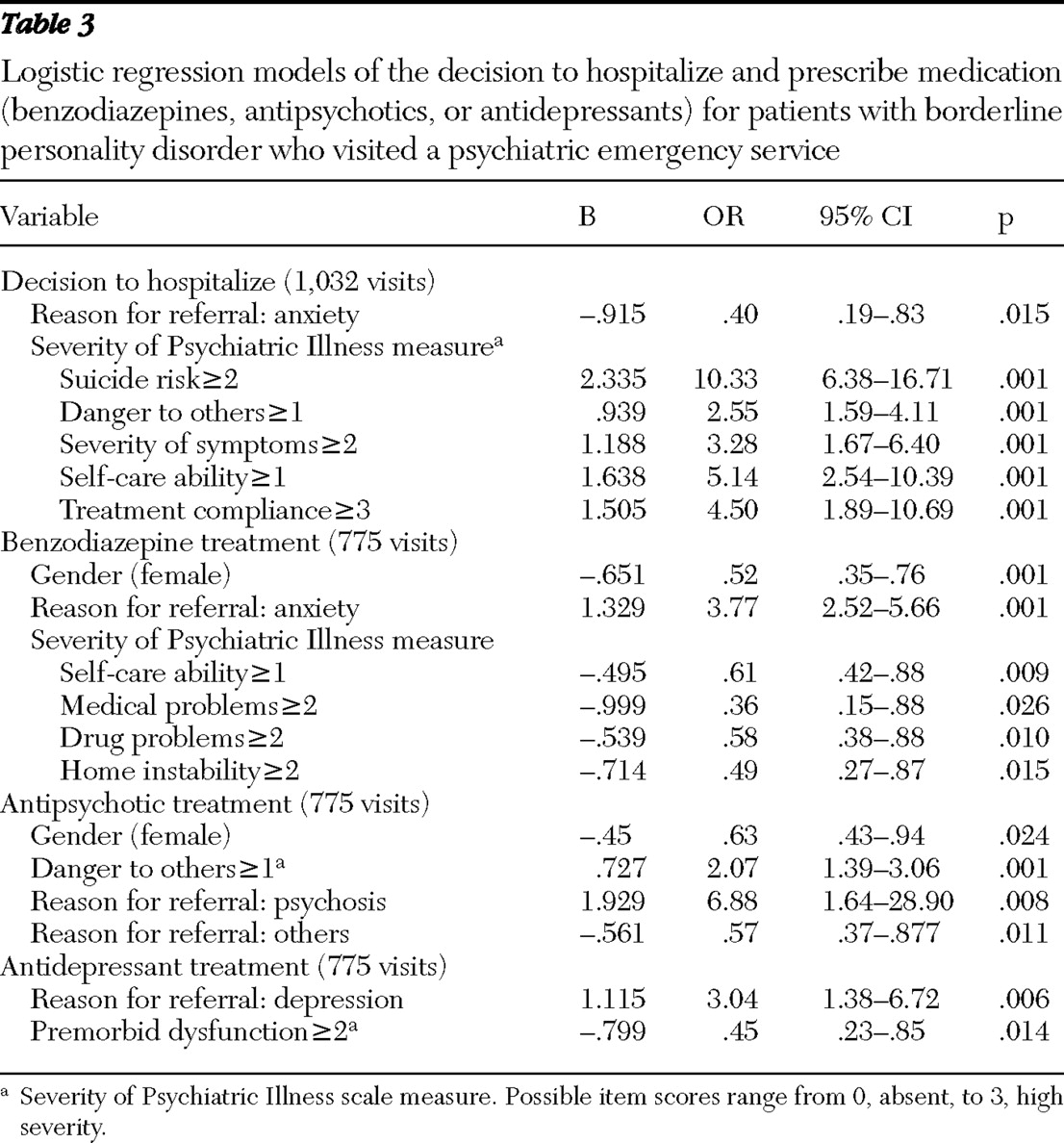Because of the many changes in psychiatric health care in recent years, particularly shorter hospitalization and fewer beds, psychiatric emergency service visits have increased substantially. Return visits are considerably more frequent (
1,
2 ). Patients with borderline personality disorder are regular users of psychiatric emergency services and consume high levels of health care and social resources (
3 ). They may present a broad spectrum of symptoms, such as severe behavioral dyscontrol, impulsive aggression, self-mutilation, psychosis-like symptoms, intense anger, and depression. Although crises are usually short-lived and resolve quickly, they tend to be severe. They are therefore often difficult to manage, and clinical and medicolegal complications may arise (
4 ). An emergency unit clinician needs to make two decisions concerning these patients: first, whether hospitalization is required, and second, what medication, if any, should be prescribed.
There is no consensus in the literature about indications for hospitalization of patients with borderline personality disorder who are having a psychiatric emergency. The American Psychiatric Association (APA) 2001 Practice Guideline for the Treatment of Patients With Borderline Personality Disorder (
5 ) recommends indications for brief hospitalization when patients present an imminent danger to others, lose control of suicidal impulses or make a serious suicide attempt, have transient psychotic episodes, and have symptoms of sufficient severity to interfere with functioning. If the APA guideline recommendations are applied, most patients with borderline personality disorder who visit psychiatric emergency services would require hospital admission, but in reality, very few patients are actually hospitalized. Furthermore, some authors, such as Linehan (
6 ) and Paris (
7 ), believe that hospitalization can be regressive, harmful, and countertherapeutic.
The second controversial question is whether psychiatrists should prescribe medications for patients with borderline personality disorder in a psychiatric emergency service setting. The APA guidelines emphasize that pharmacological treatment for these patients is symptom specific. However, these patients tend to have multiple symptoms that may lead to unlimited combinations of psychotropic medications (
8 ). Zanarini and colleagues (
9 ) found that 40% of these patients were taking three or more concurrent medications and that 20% were taking four or more. In the emergency room, patients with borderline personality disorder in crisis frequently need rapid, effective pharmacological treatment to control the situation and to decrease the risk of aggression to self and others. The aims of psychiatric emergency service interventions are to treat acute clinical problems (by administering anxiolytic or antipsychotic medication), modify existing drug regimens (such as dosage adjustment), and initiate long-term pharmacotherapy.
No empirical studies or clinical trials have been performed to investigate factors associated with clinicians' decisions to hospitalize patients with borderline personality disorder after they receive psychiatric emergency services or to prescribe psychotropics. The aims of this study were therefore to determine the factors associated with clinicians' decisions concerning these issues.
Methods
We evaluated a total of 11,578 consecutive visits over a four-year period, from January 2002 to January 2006, to the psychiatric emergency services of a university general hospital in Barcelona, Spain. This emergency service provides 24-hour care and, over the four-year study period, a total of ten attending psychiatrists had participated in the initial evaluation and treatment of the patients. Written consent to participate was not obtained, as data were taken from the routine admissions database, but the main principles outlined in the Declaration of Helsinki were followed. The study was approved by the Clinical Research Ethics Committee at Hospital del Mar.
We prospectively studied all visits according to a routine computerized protocol that comprised demographic and clinical information. Some of the patients included in the study had had more than one emergency psychiatric referral during the study period, but the unit of analysis we used was the episode of care and not the individual. Sociodemographic data included age, gender, country of origin, and social status. Clinical characteristics included reason for seeking care (grouped into six categories: psychosis, anxiety, depression, disruptive behavior, drug use, or other), referral source (self-referrals, ambulance, police, or other), previous psychiatric history, previous contact with mental health services, substance abuse or dependence, diagnosis, and current pharmacological treatment. Interventional data included hospitalization, referral to outpatient mental health services, and pharmacological prescription. Pharmacological treatment status at arrival and further medication prescribed at psychiatric emergency services were systematically recorded as of January 2003. Only the most frequently prescribed classes of medications were registered: antidepressants, benzodiazepines, and antipsychotics (both typical and atypical). Medication adjustments at psychiatric emergency services were not collected.
Each psychiatric emergency service referral received a DSM-IV diagnosis. Because patients can have more than one psychiatric diagnosis, we grouped the major mental disorders into six categories: psychotic, affective, anxiety, drug abuse, personality disorders (including borderline personality disorder), and other axis I disorders. For the purpose of this study, we divided the sample into two groups: patients with borderline personality disorder and patients without borderline personality disorder.
The severity of illness was assessed by the Spanish version of the Severity of Psychiatric Illness (SPI) scale (
10,
11 ). It was developed as a patient-level decision support tool to assess the need for services and specialty inpatient care on the basis of the patient's clinical and social factors. It is a clinician-administered rating scale consisting of 12 items that are scored on a 4-point scale that ranges from 0, absent, to 3, high severity. The items are suicide risk, danger to others, severity of symptoms, difficulty with self-care, medical problems, drug problems, job problems, family disruption, home instability, treatment compliance, family involvement, and premorbid dysfunction. The SPI was completed at the end of the emergency visit with all possible information (patients, family, and clinical records). All psychiatric emergency staff had attended an SPI training program.
Data were analyzed with the SPSS software package (version 12.0). Some of the patients included in the study had had more than one emergency psychiatric visit, but the unit of analysis we used was each episode of care rather than the individual. All hypotheses were tested with a two-tailed significance level of .05. Demographic, clinical, and service use characteristics of patients with borderline personality disorder and patients without borderline personality disorder were compared by chi square tests for categorical variables and Student's t tests for continuous variables. SPI items were compared between the two groups by the nonparametric Mann-Whitney U test. Factors associated with hospitalization and the decision to prescribe medication for patients with borderline personality disorder were examined by multivariate logistic regression analysis. Univariate analyses were conducted with variables potentially associated with these decisions. These variables were age, gender, immigrant status, previous psychiatric history, previous contact with outpatient mental health services, substance use, dual diagnosis for a co-occurring psychiatric and substance use disorder, reason for referral, and SPI items. Candidate variables were chosen a priori as an initial step toward screening for subsequent entry into a multivariate logistic regression model. Resultant associations that achieved a significance level of p<.10 were retained for entry into the final regression model. In addition, variables that were nonsignificant were screened as potential confounding variables.
Results
Of 11,578 consecutive visits to the psychiatric emergency services, 1,032 (9%) involved a diagnosis of borderline personality disorder. During the study period, some of the patients had more than one emergency psychiatric referral. Thus the total number of different individuals with borderline personality disorder in this sample was 540.
Table 1 summarizes demographic and clinical characteristics and shows differences between patients with borderline personality disorder and those without the disorder. In comparison with patients without borderline personality disorder, patients with the disorder were younger, more likely to be female, and less likely to be immigrants. Drug use and dual diagnosis were more common among the patients with borderline personality disorder, and most had a previous psychiatric history and previous contact with outpatient mental health services. Patients with borderline personality disorder were more frequently brought to the psychiatric emergency service by ambulance, the principal reason being referral for disruptive behavior (including impulsive aggression or self-mutilation). The percentage of hospitalization of patients with borderline personality disorder was lower than for patients without borderline personality disorder.
Differences in SPI scores showed that patients with borderline personality disorder had a higher total score of severity (11.62 versus 8.97 out of 36 points, p<.001), higher risk of suicide (.79 versus .41, p<.001), and greater danger to others (.53 versus .36, p<.001) than patients without borderline personality disorder. Both groups had similar levels of severity of symptoms and self-care ability. Patients with borderline personality disorder had fewer medical problems (.37 versus .59, p<.001) but more drug (1.06 versus .73, p<.001), job (.99 versus .71, p<.001), and family problems (1.66 versus 1.12, p<.001).
Factors associated with the decision to hospitalize
The rate of hospitalization was lower among patients with borderline personality disorder than among patients without the disorder. In the group of patients with borderline personality disorder, we analyzed the variables that predicted the decision to hospitalize.
Table 2 shows the candidate variables that were chosen as an initial step toward screening for subsequent entry into a multivariate logistic regression model of hospitalization. Patients with borderline personality disorder who required admission were more likely to have had a previous psychiatric history, previous contact with psychiatric services, greater risk of suicide or being a danger to others, higher levels of severity of symptoms, less self-care ability, reasons for referral other than anxiety, more medical problems, family disruption, home instability, premorbid dysfunction, and greater noncompliance with treatment.
Table 3 shows the final logistic regression model. Independent significant predictors of the decision to hospitalize were greater risk of suicide, being a danger to others, highly severe symptoms, difficulty with self-care, and lack of treatment compliance. The decision to hospitalize was less likely for patients whose reason for referral was anxiety. The receiver operator characteristic analyses according to the final logistic regression model show that the area under the curve obtained was .88 (p<.001, 95% confidence interval=.85–.91).
Factors associated with the decision to prescribe medications
On arrival at the emergency service, 356 patients (46%) with borderline personality disorder were taking antidepressants, 349 (45%) benzodiazepines, and 217 (28%) antipsychotics. Further medications prescribed at psychiatric emergency services were benzodiazepines for 162 patients (21%), antipsychotics for 141 patients (18%), and antidepressants for only 42 patients (5%).
Table 3 presents the final logistic regression model concerning the decision to prescribe benzodiazepines, antipsychotics, or antidepressants. Patients with borderline personality disorder who required benzodiazepine prescription were more likely to be men, with less severe symptoms, greater self-care ability, and fewer medical, drug, and family problems. The main reason for referral was anxiety. Disruptive behavior, drug use, or "other causes" were less frequent. In the final logistic regression model, independent significant predictors of prescription of benzodiazepines were being male, less difficulty with self-care, fewer medical and drug problems, greater home stability, and anxiety as the reason for referral.
Patients with borderline personality disorder who required antipsychotic prescription were more likely to be men, with higher drug use, greater risk of danger to others, less self-care ability, and psychosis as the main reason for referral. Independent significant predictors were male gender, higher risk of danger to others, and psychosis as the most frequent reason for referral.
Variables that were significant predictors of the need for antidepressants were female gender, less drug abuse, more family disruption, more premorbid dysfunction, and depressive symptoms as the main reason for referral. Independent significant predictors for antidepressant prescription were depression as the reason for referral and less premorbid dysfunction.
Discussion
To our knowledge, this is the first study to empirically assess factors associated with decisions to hospitalize and prescribe medication for patients with borderline personality disorder in a psychiatric emergency service setting. We found that in 9% of psychiatric emergency service visits, borderline personality disorder was the diagnosis. In comparison with patients without borderline personality disorder, this group was younger and more likely to be female, and substance use disorder and dual diagnosis were more common. Our findings indicate that most of these patients had a history of psychiatric problems and previous contact with outpatient mental health services. On the SPI rating scale, patients with borderline personality disorder had the highest total score of severity, greater risk of suicide and danger to others, and fewer medical problems but more drug, job, and family problems.
Two main findings emerged from this study. First, although patients with borderline personality disorder had greater clinical severity and more social problems, the percentage of hospitalizations was lower than for patients without borderline personality disorder. A possible explanation for this may be that the emergency clinician often considers that the crises tend to resolve within a short period, that hospitalization in a conventional unit is not helpful for these patients, or that these patients can be potentially disruptive to hospital units. In practice, the clinician generally prefers outpatient treatment or partial hospitalization. The factors associated with the decision to hospitalize were risk of suicide, danger to others, severe symptoms, difficulty with self-care, and lack of compliance with treatment. Hospitalization was less frequent if the reason for referral was anxiety. In contrast with APA practice guidelines (
5,
12 ), psychotic symptoms were not an indication for hospitalization; in only 11 of 1,032 visits (1%) were patients with borderline personality disorder referred for psychotic symptoms, and hospitalization was required in only one instance. On the other hand, our results were consistent with these guidelines to confirm the other three indications for brief hospitalization: imminent danger to others, loss of control of suicidal impulses or serious suicide attempt, and symptoms of sufficient severity to interfere with functioning (greater severity of symptoms and less self-care ability). Furthermore, we found that lack of compliance independently predicted admission. Although lack of treatment compliance could reflect nonacceptance of need for help, it might also be influenced by the compulsory hospitalization laws or the mental health system in each country (
13 ).
The second finding of note is that, although a psychiatric emergency service is not the best setting in which to initiate pharmacotherapy, in practice, psychiatrists frequently prescribe medications for patients with borderline personality disorder in emergency units. In our study, a majority of patients with borderline personality disorder were receiving pharmacological treatment when they were referred to the psychiatric emergency service. Previous studies also indicate that these patients are prescribed a greater number of psychotropic medications than patients without borderline personality disorder (
8,
14 ). As for the medications newly prescribed in the psychiatric emergency service setting, in 21% of visits clinicians initiated treatment with benzodiazepines and in 18% with antipsychotics to treat acute clinical problems.
We analyzed the factors associated with the clinician's decision to prescribe either anxiolytic or antipsychotic medication. Benzodiazepines were chosen for patients with less clinical severity, when the reason for referral was anxiety and when there was less difficulty with self-care and fewer medical and drug problems. Nevertheless, antipsychotics were prescribed more often to male patients and were associated with higher risk of danger to others, less self-care ability, higher drug use, and psychosis as the reason for referral. Although antipsychotics were usually reserved for higher clinical severity, recent studies suggest that second-generation antipsychotics, such as olanzapine or ziprasidone, are a useful and safe treatment for patients with borderline personality disorder in acute exacerbations (
4,
15 ). These medications are thought to improve mood and anxiety symptoms and reduce impulsive and aggressive behaviors (
16 ). Finally, for only 5% of patients was treatment initiated with antidepressants. The psychiatric emergency service is probably not the most suitable setting to initiate long-term de novo pharmacotherapy for patients with borderline personality disorder, and this decision should be made by the patient's regular psychiatrist.
Another consideration raised by these data is that the SPI scale was a good tool for assessing severity of illness in a psychiatric emergency service for patients with borderline personality disorder, and it predicted a large proportion of hospitalization decisions. Moreover, social factors may influence clinicians' decisions with patients with borderline personality disorder, and the SPI is based on the patient's clinical and social characteristics.
This study has some significant limitations. First, psychiatric diagnosis was limited to the information available at the emergency service, because a complete history or structured interview is not usually feasible in this setting. However, 95% of patients with borderline personality disorder had a previous psychiatric history and a previous
DSM-IV diagnosis in outpatient mental health services. Moreover, prior studies indicate a high reliability among diagnoses made by psychiatric emergency service clinicians (
17 ). Second, comorbid diagnoses other than substance abuse or dependence may also bear on the clinician's decision, and we did not analyze these in our study because every psychiatric emergency service visit received only one principal diagnosis. It is possible that patients diagnosed as having an affective, anxiety, or drug abuse disorder were also patients with borderline personality disorder. Third, most patients with borderline personality disorder in our sample were currently taking pharmacological treatment, and these medications may have influenced psychiatric emergency unit prescription decisions. Information concerning adjustment of previous medication was not collected. Finally, other factors that were not investigated could influence the decision-making process; these include the mental health service system, restrictions on the criteria for inpatient hospitalization, and difficulties with outpatient mental health follow-up.
The findings of this study reflect practice patterns from a single urban emergency unit in Spain, and their generalization to other institutional settings and other countries may be limited. The study design did not examine the possible benefits of the clinical decisions, and therefore, recommendations cannot be made.
Conclusions
Our findings indicate that although patients with borderline personality disorder had more clinical severity than patients without the disorder, the percentage of hospitalizations was lower. The decision to hospitalize was associated with risk of suicide, danger to others, severity of symptoms, difficulty with self-care, and noncompliance with treatment. The decision to prescribe benzodiazepines was related to being a male patient, anxiety as the reason for seeking care, little difficulty with self-care, few medical or drug problems, and home instability. Factors related to the prescription of antipsychotics were being male, risk of endangering others, and psychosis as the reason for the visit. Factors associated with the prescription of antidepressants were depression as the reason for seeking help and little premorbid dysfunction.
This was a naturalistic study that addressed actual practice at an emergency service with respect to patients with borderline personality disorder. Future clinical research designed to analyze the effect of clinicians' decisions is needed.
Acknowledgments and disclosures
This study was supported by grants from the Fondo de Investigación Sanitaria (Ministry of Health, Spain), from REM-TAP. The authors thank the emergency psychiatric clinicians at Hospital del Mar for their participation.
The authors report no competing interests.




